








The NEBRASKA MUNICIPAL REVIEW (ISSN 0028–1906) is published monthly and the official publication of the League of Nebraska Municipalities, an association of the cities and villages of Nebraska, published at 1335 L St., Lincoln, Nebraska 68508. Subscription rates are $5 per single copy — $50 plus tax for 12 issues. Periodicals postage paid at Lincoln, Nebraska. Views of contributors, solicited or unsolicited, are their own and not to be construed as having the endorsement of the League unless specifically and explicitly stated by the publisher
The NEBRASKA MUNICIPAL REVIEW is a nonprofit publication administered and supervised by the League of Nebraska Municipalities. All revenue derived from the publication is used by the association to defray publication costs.
League of NE Municipalities staff 402-476-2829 • www.lonm.org
L. Lynn Rex, Executive Director
Christy Abraham, Legal Counsel
Lash Chaffin, Utilities Section Director
Cherie DeFreece, Admin Assistant/ Membership Services Assistant
Brenda Henning, Membership Services Assistant
Ethan Nguyen, LNM/LARM Information Technology Manager
Shirley Riley, Membership Services Director
Jackson Sash, Utilities Field Representative/Training Coordinator
Ashley Wolfe, Marketing/Communications Director
LARM staff
Dave Bos, Executive Director
Tracy Juranek, Asst. Executive Director, Customer Service Specialist
Diane Becker, Communications/Marketing Director
Kyla Brockevelt, Executive Administrative Assistant
Drew Cook, Customer Service Specialist
John Hobbs, Loss Control Specialist
James Kelley, Loss Control Specialist
Fred Wiebelhaus, Loss Control/Claims Manager
POSTMASTER: SEND ADDRESS CHANGES TO NEBRASKA MUNICIPAL REVIEW, 206 S. 13TH ST., STE 800, LINCOLN, NEBRASKA 68508.
Have an idea, project or opinion to share? The League welcomes member articles, information, and op-eds.
Want to reach local decision makers? The League can help you get your message out to Nebraska’s 3,500+ municipal officials.To learn more, contact Ashley Wolfe at 402-476-2829 or ashleyw@lonm.org
President Marlin Seeman, Mayor, Aurora
President-Elect Bryan Bequette, Mayor, Nebraska City
Vice President Joey Spellerberg, Mayor, Fremont
Past President Deb VanMatre, Former Mayor, Gibbon
Directors
Jean Stothert Mayor, Omaha
Leirion Gaylor Baird Mayor, Lincoln
Sharon Powell Village Board President, Utica
David Black Mayor, Papillion
Larry Evans Mayor, Minden
Rod Petersen Mayor, Louisville
David Scott City Manager, Sidney Jim Bulkley Mayor, Columbus
Janine K. Schmidt CMC/Treasurer, Morrill
Layne Groseth City Administrator/Utilities Manager, North Platte
Affiliated Sections
City Managers
Eric Melcher, Aurora Clerks Kellie Crowell, Ravenna Munic. Accounting & Finance
Brandi Kloepping, Cozad Fire Chiefs Dennis Thompson, North Platte Utilities Duane Hoffman, Oxford
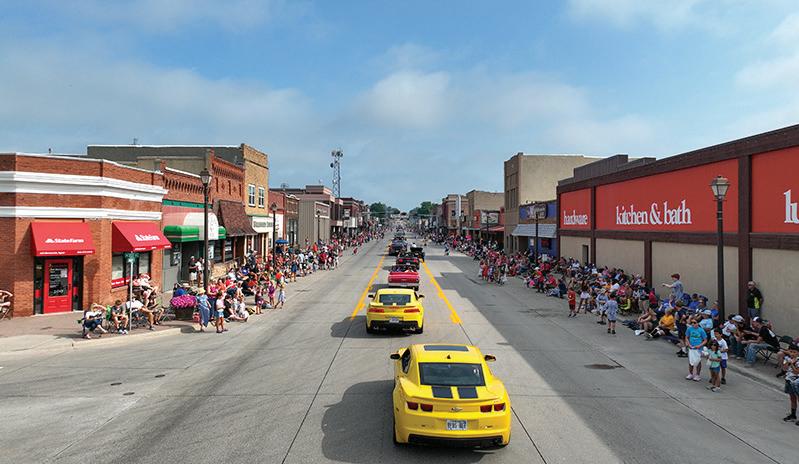
Mayor Marlin attends NLC conference, helps guide legislative priorities for upcoming year
Looking back: Mayor Deb delivers farewell address to Gibbon City Council
‘Bright future for greater Nebraska’ - Survey shows rural students want to stay in state
Minatare welcomes new Clerk
National State of the Cities report now available
Sutton: Expanding the city’s footprint for housing growth
15
Energy Efficiency and Conservation Block Grant awarded to 12 municipalities
NLC: U.S. Supreme Court 2024-25 Term Preview
New federal grant provides funding for community-driven projects supporting healthy environments
On the national stage … Norfolk wins award for innovative projects
City of Grand Island rolls out new website
30
NDED announces $10 million of awards through Rural Community Recovery Program
4
The Director's Message - L. Lynn Rex, LNM Executive Director - Passing bills to amend the LB 34 Property Tax Cap will be a top priority for the League and NACO in the 2025 legislative session!
The Legal Corner by Tara Stingley, Madeline Hasley and Sydney Huss, Cline Williams Wright Johnson & Oldfather, L.L.P. - Federal court overturns FLSA salary threshold previously approved by U.S. DOL
LARM – Workplace harassment and discrimination liabilities
Photo of the Gage County Courthouse in Beatrice lit up for the holidays. Photo provided by the City of Beatrice.
John McGhehey, Mayor, Alliance
Seth Sorensen City Manager, Alliance
Tobias Tempelmeyer City Administrator, Beatrice
Rusty Hike, Mayor, Bellevue
Jim Ristow, City Administrator, Bellevue
Mindy Rump, Mayor, Blair
Phil Green, City Administrator, Blair
Miles Bannon, Council Member, Chadron
Tom Menke, City Manager, Chadron
Jim Bulkley, Mayor, Columbus
Tara Vasicek, City Administrator, Columbus
Dave Bauer, Mayor Crete
Tom Ourada, City Administrator, Crete
Joey Spellerberg, Mayor, Fremont
Jody Sanders, City Administrator, Fremont
Kent Ewing, Mayor, Gering
Pat Heath, City Administrator, Gering
Laura McAloon, City Administrator, Grand Island
Mike Evans, Mayor, Gretna
Paula Dennison, City Administrator, Gretna
Corey Stutte, Mayor, Hastings
James Liffrig, Mayor, Holdrege
Chris Rector, City Administrator, Holdrege
Brenda Jensen, City Manager, Kearney
Doug Kindig, Mayor, La Vista
John Fagot, Mayor, Lexington
Joe Pepplitsch, City Manager, Lexington
Margaret Blatchford, Assistant City Attorney, Lincoln
Riley Slezak, Senior Advisor to the Mayor, Lincoln
Linda Taylor, Mayor, McCook
Nate Schneider, City Manager, McCook
Bryan Bequette, Mayor, Nebraska City
Perry Mader, City Administrator, Nebraska City
Andrew Colvin, City Administrator, Norfolk
Dani Myers-Noelle, City Attorney, Norfolk
Brandon Kelliher, Mayor, North Platte
Layne Groseth, City Admin./Utilities Manager, North Platte
Steve Krajewski, Mayor, Ogallala
Kevin Wilkins, City Manager, Ogallala
Thomas Warren, Chief of Staff, Omaha
David Black, Mayor, Papillion
Amber Powers, City Administrator, Papillion
R. Paul Lambert, Mayor, Plattsmouth
Emily Bausch, City Administrator, Plattsmouth
Don Groesser, Mayor, Ralston
Brian Kavanaugh, Council Member, Ralston
William De Roos, City Administrator, Schuyler
Jeanne McKerrigan, Mayor, Scottsbluff
Kevin Spencer, City Manager/Police Chief, Scottsbluff
Joshua Eickmeier, Mayor, Seward
Greg Butcher, City Administrator, Seward
Brad Sherman, Mayor, Sidney
David Scott, City Manager, Sidney
Carol Schuldt, Council Member, South Sioux City
Lance Hedquist, City Administrator, South Sioux City
Cale Giese, Mayor, Wayne
Jill Brodersen, Council President, Wayne
Wes Blecke, City Administrator, Wayne
Barry Redfern, Mayor, York
Dr. Sue Crawford, City Administrator, York
Jessica Quady City Administrator, Ashland
Marlin Seeman, Mayor, Aurora
Eric Melcher, City Administrator, Aurora
Chris Anderson, City Administrator, Central City
Andrew Lee, Admin/Clerk/Treasurer, Curtis
Alan Michl, Chairperson, Exeter
Becky Erdkamp, Clerk/Treasurer, Exeter
Kyle Svec, City Administrator, Geneva
Matt Smallcomb, City Administrator, Gibbon
Gary Greer, City Administrator, Gothenburg
Jana Tietjen, Clerk, Hebron
Barb Straub, Admin/Clerk/Treasurer, Hemingford
Kelly Oelke, City Administrator, Hickman
Janine K. Schmidt, CMC/Treasurer, Morrill
Sandra Schendt, Clerk/Treasurer, Nelson
David Russell, Director of Gov. Affairs, NMPP Energy
Mandy Hansen, Government Affairs Liason, NMPP Energy
Sandy Kruml, Clerk/Treasurer, Ord
Mike Feeken, Mayor, St. Paul
Sandra Foote, Council Member, Superior
Jeff Hofaker, City Administrator, Sutton
Jessica Meyer, City Administrator, Syracuse
Sharon Powell, Village Board President, Utica
Kyle Arganbright, Mayor, Valentine
Melissa Harrell, City Administrator, Wahoo
Desiree Soloman, City Attorney, Waterloo
Stephanie Fisher City Administrator, Waverly
Tom Goulette, City Admin./Utility Superintendent, West Point
Randy Woldt, Utilities Superintendent, Wisner
Robert Costa, Community Engagement Coordinator, Yutan

(All statute citations to Revised Statutes of Nebraska)
CITIES OF THE FIRST CLASS
• Within 15 days of Passage Clerk publishes ordinances passed. (16-405)
• Within 10 days from meeting or before next meeting (whichever is sooner) Clerk to have minutes available for public inspection. (84-1413)
• On or before second Monday - Annual Library Board report due (51-213)
• Within 30 days from Council meeting Clerk publishes official proceedings of meeting. (19-1102)
• Within 20 days after end of month Treasurer files monthly financial report. (16-318)
• * * Clerk must prepare agenda prior to next Board meeting. (84-1411)
CITIES OF THE SECOND CLASS
• Within 15 days of Passage Clerk publishes ordinances passed. (17-613)
• Within 10 days from meeting or before next meeting (whichever is sooner) Clerk to have minutes available for public inspection. (84-1413)
• On or before second Monday - Annual Library Board report due. (51-213)
• Within 30 days from Council meeting Clerk publishes official proceedings of meeting. (19-1102)
• Within 20 days after end of month Treasurer files monthly financial report. (17-606)
• * * Clerk must prepare agenda prior to next Council meeting. (84-1411)
• Within 15 days of Passage Clerk publishes ordinances passed. (17-613)
• Within 10 days from meeting or before next meeting (whichever is sooner) Clerk to have minutes available for public inspection. (84-1413)
• On or before second Monday - Annual Library Board report due. (51-213)
• Within 30 days from Trustees’ meeting Clerk publishes official proceedings of meeting. (19-1102)
• Within 20 days after end of month Treasurer files monthly financial report. (17-606)
• * * Clerk must prepare agenda prior to next Board meeting. (84-1411)


One of the League’s top priorities in the 2025 legislative session will be passing bills to amend the Property Tax Growth Limitation Act (PTGLA) enacted with passage of LB 34 during the Special Session on Aug. 20, 2024. LB 34 imposed property tax caps on municipalities and counties which will take effect July 1, 2025, replacing the “lid on restricted funds”; the Property Tax Growth Limitation Act is codified in Sections 13-3401 to 13-3408. For FY 2425, municipalities and counties remain subject to the “lid on restricted funds” in Sections 13-518 to 13-522.
Special thanks to Ralston Sen. Merv Riepe for contacting the League and the Nebraska Association of County Officials (NACO) to offer assistance in amending LB 34 to make the Property Tax Cap workable and equitable for all municipalities and counties. The League and NACO also thank Elkhorn Sen. Brad von Gillern, currently Vice Chair of the Revenue Committee, for meeting with us to review needed technical amendments to LB 34 to reflect the Legislature’s intent when the bill passed in the 2024 Special Session. Although Sen. von Gillern has not agreed with all our proposed technical changes, we are hopeful he will be supportive of the most important amendments. The League and NACO as well as municipal and county officials also have been visiting with other Senators and the Governor about the need to amend
Passing bills to amend the LB 34 Property Tax Cap will be a top priority for the League and NACO in the 2025 legislative session!
BY L. LYNN REX, EXECUTIVE DIRECTOR, LNM
the LB 34 Property Tax Cap.
As authorized by the League Executive Board and NACO Board of Directors, two separate bills will be introduced in the 2025 session to clarify and amend the LB 34 Property Tax Cap on municipalities and counties:
1. A technical cleanup bill to clarify provisions and address the unintended consequences of the current language to accurately reflect the intent of the Legislature; and
2. A bill: a) to allow a municipality or county to benefit from its growth percentage ; and b) if public safety services as defined in Section 13-320 account for less than 20% of the political subdivision’s budget funded by property tax, such political subdivision’s property tax request authority may be increased using a calculation which includes the provision for “the greater of 2% or the inflation percentage” instead of “the greater of zero or the inflation percentage.”
1. Growth percentage: Amend Section 13-3403 of the PTGLA (Section 3 of LB 34) relating to the calculation for determining a political subdivision’s property
tax request authority so the municipality or county can benefit from its growth percentage as intended in LB 34.
2. Public safety services exception: Amend Section 13-3404 of the PTGLA (Section 4 of LB 34) to clarify the exception to the cap for expenditures relating to public safety services as defined in Section 13-320 to include: “the amount of property taxes budgeted for substance abuse, behavioral health, and opioid prevention.”
3. Other exceptions to the cap: Amend Section 13-3404 of the PTGLA (Section 4 of LB 34) to include as exceptions to the cap: “The amount of property taxes budgeted for matching state and federal grants; and the amount of property taxes needed to replace any revenue stream collected in the prior year that was eliminated or reduced through legislative action.”
4. Delete provision relating to date of elections for voter overrides: Amend Section 13-3405(2) of the PTGLA (Section 5 of LB 34) to delete the following provision requiring elections for voter overrides of the cap to be “held on the first Tuesday after the second Monday in May of an oddnumbered year.” (This requirement is not timely or workable.)
5. Transition provision for carrying forward unused property tax request authority: Amend Section 13-3406 of the PTGLA (Section 6 of LB 34) to provide as follows: “In FY 25-26, a political subdivision may choose to carry forward as unused property tax request authority an accumulation of unused restricted funds authority from FY 24-25 as permitted by Section 13-521, not to exceed an aggregate of 5% of the total property taxes levied for the political subdivision in FY 24-25.”
6. County treasurer retains 1% of receipts for costs: Amend Section 77-7305 of the School District Property Tax Relief Act (Section 13 of LB 34) to provide as follows: “The county treasurer shall retain 1% of receipts for costs before allocating the remaining receipts as provided in this section.”
7. Change definition of allowable growth in the “lid on restricted funds”: Amend Section 13-518 relating to the “lid on restricted funds” (Section 15 of LB 34) to match the definition of GROWTH VALUE in the LB 34 cap (Section 13-3402(5) of the PTGLA; Section 2 of LB 34). Although the definitions of “allowable growth” in the “lid on restricted funds” and “growth value” in the PTGLA are almost the same, making these definitions the same will provide less confusion and greater transparency for citizens as well as assist county assessors by having these definitions the same. Although municipalities and counties will not be subject to the “lid on restricted funds” after July 1, 2025, other political subdivisions will continue to be subject to the “lid on restricted funds.”
9. Repeal of occupation tax caps as intended for inclusion in LB 34 by several key Senators: Amend the following statutes to repeal the occupation tax caps: Sections 14-109, 15-202, 15-203, 16-205, 17-525, and 18-1208. Several key Senators assumed repealing the caps on occupation taxes was included in LB 34 (as intended) when it passed during the 2024 Special Session. This is understandable since there were numerous bills and amendments considered by the Legislature during the Special Session which lasted 17 legislative days. (Lincoln Sen. Jane Raybould introduced LB 80 during the 2024 Special Session on behalf of the League and NACO; although LB 80 did not pass, the bill included the repeal of the occupation tax caps in Sections 13-18.)
The first day of the 109th Legislature, 1st Regular Session, is Jan. 8, 2025. The tentative legislative calendar issued by Speaker John Arch of La Vista identifies June 18, 2025, as the 90th day for the “long session.” Bills that did not pass in the 90-day “long session” in 2023 or the 60-day “short session” in 2024 do not “carry over” to the 2025 session and will need to be reintroduced for consideration. Due to a recent rule change taking effect in the 2025 session, Senators are limited to introducing only 20 bills and committees are limited to
8. Clarify information on the property tax statement relating to the amount of property taxes due to fund “public safety services”: Amend Section 77-1701 (Section 22 of LB 34) to provide as follows: “Such statement shall clearly indicate, for each political subdivision, the amount of property taxes due to fund any and all public safety services whether taken as an exception (to the cap) as provided in Section 4 of this act.”
introducing only 10 bills. Consequently, it is more difficult to get bills introduced in the upcoming session on behalf of the League when Senators are inundated with legislative requests from constituents and a wide variety of interest groups. The League’s advocacy before the Legislature on behalf of the 527 cities and villages in Nebraska is critically important to provide municipal officials the statutory authority needed to effectively govern and provide necessary services and programs to citizens. While many bills introduced on behalf of the League are major proposals, other League bills are relatively minor but essential since the Nebraska Supreme Court has consistently upheld “Dillon’s Rule,” strictly construing legislative grants of power. “A municipal corporation possesses and can exercise these powers only: 1) those granted in express terms; 2) those necessarily or fairly implied in, or incident to, the powers expressly granted; and 3) those essential to the declared objects and purposes of the municipality, not merely convenient, but indispensable.”
Your relationship with your Senator(s) is extremely important! Please continue visiting with your Senator, especially throughout the legislative session. We appreciate the Senators who introduce bills on behalf of the League and work with our advocacy team throughout the session. A special thanks to municipal officials serving on the League Executive Board as well as the League Larger and Smaller Cities Legislative Committees. These officials commit a significant amount of time assisting the League staff in developing the League legislative package, advocating for passage of important municipal initiatives, and helping to oppose bills detrimental to the interests of cities and villages. Every member of the League staff is involved in the League’s legislative efforts, including preparation of the weekly League Legislative Bulletin published during the legislative session as well as legislative alerts when needed.

“
Nancy and I had a wonderful experience meeting a wide-range of individuals from across the United States, listening to inspirational speakers, and participating in the 100th celebration of NLC.
”
InOctober, Mayor Marlin Seeman of Aurora was elected President of the League of Nebraska Municipalities and in November, he and Nancy were on a plane to Florida so Mayor Marlin could serve as a sponsored delegate to represent the League at the National League of Cities City Summit in Tampa.
NLC has a long history of representing municipalities on the federal stage. The group first convened in 1924 in Lawrence, KS, as a means of states cooperating and advocating for legislation beneficial to city, state and national interests. Over the next 100 years, the organization expanded in both in size and impact, and now represents nearly 3,000 cities and is the top resource and advocate for local governments across America.
As a delegate for the 2024 Business Meeting, Mayor Seeman assumed the role of voting on resolutions proposed for the coming year to guide priorities of NLC. The convention was attended by over 4,000 diverse representatives from across the nation.
Mayor Seeman attended general sessions including one by Lyndsey Vonn, Olympic Skier, sharing her journey, setbacks, and determination to meet her personal goals as well as other

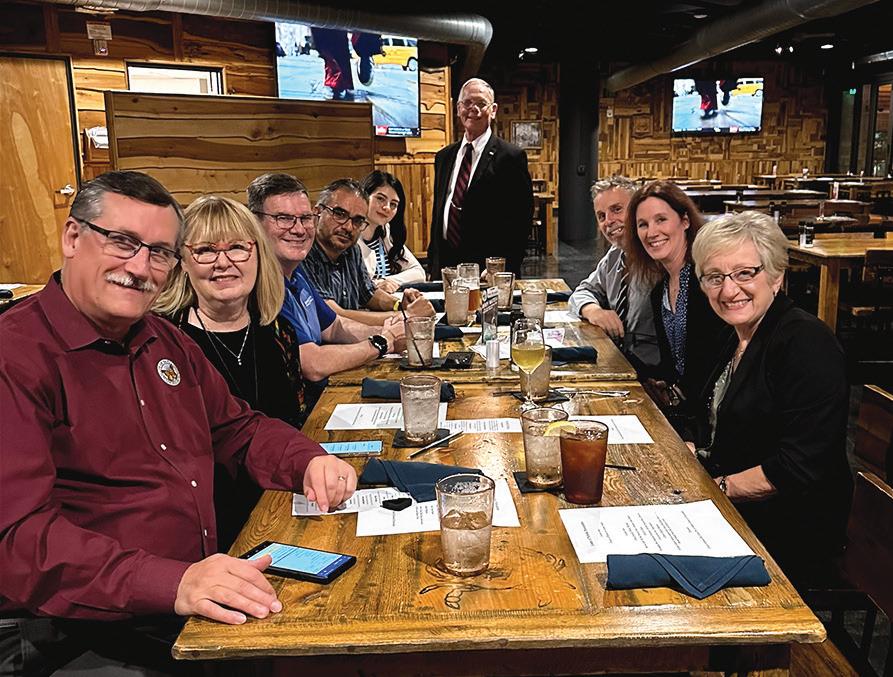
motivational speakers. He also attended many informative workshops related to his role as mayor and advocate for city priorities including:
• volunteerism as a force;
• attracting and retaining talent in the new world of work;
• crafting priority-based budgets;
• cybersecurity readiness;
• water for the long term: finding the right governance model for water sustainability; current and new drinking water regulations;
• managing small city council meetings;
• fostering AI adoption: creating a supportive policy environment for local businesses;
• buy local, thrive local;
• honest conversations about public safety and community perception;
• winning and managing federal infrastructure grants;
• identifying basic needs for thriving communities; and
• building bridges with trust and civility
Highlights of the convention included hosting a reception and meal for the Nebraska representatives, building relationships with other team leaders from many states, visiting the YBOR historical Cuban district, sampling ethnic foods, as well as, seafood along the River Walk and culminating in the “Centennial Celebration” with a beautiful banquet, outdoor fireworks on the river, and a nostalgic concert by the l960s-70s music of the “Temptations!”
Editor’s note: A version of this story was also submitted to run in the Aurora Register. Thank you to Mayor Marlin and Nancy Seeman for providing the written content for this article.


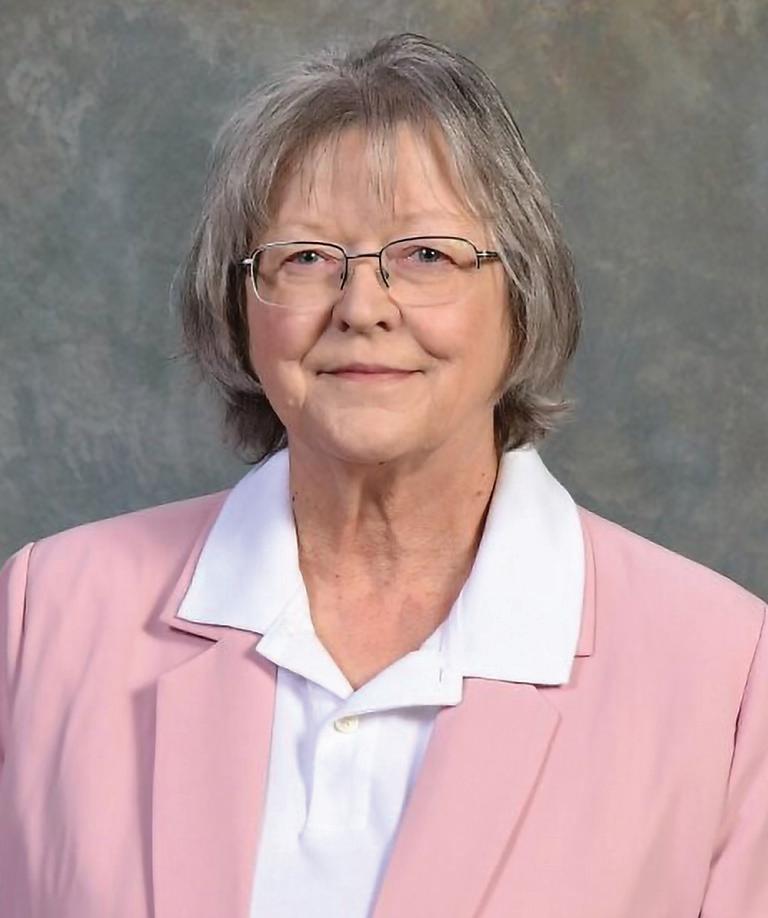
BY DEB VANMATRE, FORMER MAYOR OF GIBBON, IMMEDIATE LEAGUE PAST PRESIDENT
Editor's note: After reading former Mayor VanMatre’s exceptional farewell address on the city’s website, the League asked for her permission to publish it in the Review. Although she did not write it for a statewide audience, we thank her for allowing us to print her remarks underscoring the extraordinary progress in the City of Gibbon.
“Having come to the end of our fiscal year, as well as my term of office, I wanted to take this opportunity to address the council and public on our many accomplishments and where we stand going forward.
You’ve probably all heard the metaphor of the frog and water. The scenario is that a frog would leap away if put into a pan of hot water, but if the water is heated gradually, it won’t notice until it is too late. The gist is that it is easy to miss small changes that build up over time and it usually has a negative connotation. However, the opposite is also true. Positive changes can happen in the same way, adding up over time without us realizing it.
I recently had the opportunity to take a group of elected officials on a tour of our city, many from communities much larger than ours. In preparation, I thought about what to include on the tour that would be of interest to them as well as what changes have occurred over the past 12 years. You’re invited to mentally come along on that tour.
To our east you will notice improvements which have been made to the Legion Ball fields, and as we leave the parking lot and look south, you’ll see Clevenger’s. Turning north, we’ll pass the day care and chiropractor and then we’ll pass the nine soon to be ten new homes on Turkey Drive. As we approach Pine Street, you’ll be reminded of the annexation and improvements made to 8th Street. Going north, you will pass the new swimming pool, including the addition of playground equipment and other amenities. Next we’ll enter Rosen Park where improvements include new lights and a walking track along with other improvements to our soccer fields. Looking across the fields is Rasmussen Mechanical’s regional office and Cargill, both having made
significant investments in their Gibbon facilities.
As we head back to Court Street you’ll notice the 12 new homes which were built on the previous school property. Twelve years ago there were two, which were for sale along with 16 other properties in town. In addition to the two sub-divisions, there have been many other homes built on individual lots.
Moving toward downtown, the Heritage Center board has continued to make improvements both inside and out, and the property was approved by the Department of the Interior for placement on the National Register of Historic Places. They also led the City’s 150th celebration. Across the street is our library, which was recognized as a Scholastic Top Library. They continue to add quality programming for all ages. Moving on, you’ll notice Pioneer Park, which has also had new equipment installed in addition to being the home to our Christmas in the Park community celebration.
Along with changes in ownership for Adam’s, Hamilton, Pistoleros and the Food Pantry, many of our businesses on LaBarre and Front Street have made significant investments and improvements both inside and out. Gibbon Insurance, Exchange Bank, Dynamic T’s, Rise and Grind, Axes, Central Nebraska Cremation and Burmoods to point out a few. The Community Beautification Foundation was established last year, added flowers this summer with plans for more projects moving forward.
Moving on to Highway 30, Gibbon Packing has made and will continue to make considerable investments in their plant. They have also been a great partner in
“While there are so many positives, we all know that we have faced many challenges as well. Two hailstorms, two floods, two fires, two train derailments ... Despite this, we have prevailed, succeeded, and excelled.”
Deb VanMatre Former Gibbon Mayor & League Past President
providing funding for several community projects through the Rosen Foundation.
As we go past Davis Park, you’ll see numerous updates to playground equipment and the baseball field, and additions of disc golf and pickle ball.
Returning to Highway 30 you will see numerous new businesses and improvements. A change in the entry point for Gibbon Packing, Triple S, Bond’s building which includes Lucky Duck and Railside, Casey’s, Kwik Stop addition, Dollar General and Froth and Fizz.
There have been many changes within the city limits, but you’ll also find numerous improvements at the cemetery including the new directory and at the municipal golf course, which added to our quality-of-life options and brings in many golfers from out of town.
Before we finish our tour, there are other aspects of leadership and city government that I want to point out. Administratively, we have updated our zoning, sub-division and municipal codes, employee handbook, comprehensive plan, strategic plan and website; gone paperless and streamlined our agenda for council meetings; participated with the UNL Rural Fellows; became a Leadership Certified Community and received recognition for our Excellence in Economic Impact by the Economic Development Council of Buffalo County. In my opinion the main function of local government boils down to infrastructure, safety and quality-of-life. During our tour we’ve seen the focus we have had on the latter. As far as infrastructure is concerned, we’ve made improvements to our streets, most notably Gibbon Road and the Cargill crossing. We have made considerable investment and improvements to our wastewater treatment plant.
We live in a safe community, where I was once told parking and barking were our main concerns. Not to take it lightly, but we are fortunate with the coverage provided by the Buffalo County Sheriff’s Office and our relationship with their personnel. We’ve added recycling at no cost to our residents. We’ve made changes at the request of local businesses, such as changes to our alcohol sales days and times to compete with the interstate businesses, and voter approved Keno
which was of mutual benefit to businesses and the city.
Speaking of voter approval, we want to return to our tour, and to the downtown area. Thanks to their approval, we were able to provide our volunteer firefighters with updates and additions to the firehall that were greatly needed, including new bays, personal facilities and other improvements both interior and exterior.
To finish our tour, we will return to where started, which is here. While not in the original plan, the acquisition of this facility provided another asset for our community. The price was right, and along with the grants and donations, we were able to provide community space for nonprofit organizations, room for other meetings and celebrations, along with a city office and council room which will meet our needs for years to come.
While there are so many positives, we all know that we have faced many challenges as well. Two hailstorms, two floods, two fires, two train derailments, COVID-19 and the supply issues and increased costs that followed, and changes in administrative personnel.
Despite this, we have prevailed, succeeded and excelled. While city government and staff are not responsible for everything I’ve pointed out, none of this would have happened if we weren’t a great place to live and do business, and none of this would be possible without the support of the citizens of Gibbon, the volunteers on our city boards and commissions, our council leadership, our city officials and our employees. My personal thanks go out to Matt and Pam, as well as Susan and Barry. It has been my pleasure to work with all of you.
It has been an honor and a privilege to serve as your mayor for the last 12 years. This completes 40 years of community and public service to my hometown in a variety of roles. It is time for new leadership, and it is reassuring to know that our city is in good hands to continue our path forward. There will still be challenges, but we are in a good place, and I have confidence in the leadership Mayor-Elect Leon will provide along with the expertise of our city administration.
Remember the frog? If you’re like me, the changes have been gradual, but it’s good to know that we continue to get better each and every day.”
Thank you! Mayor Deb
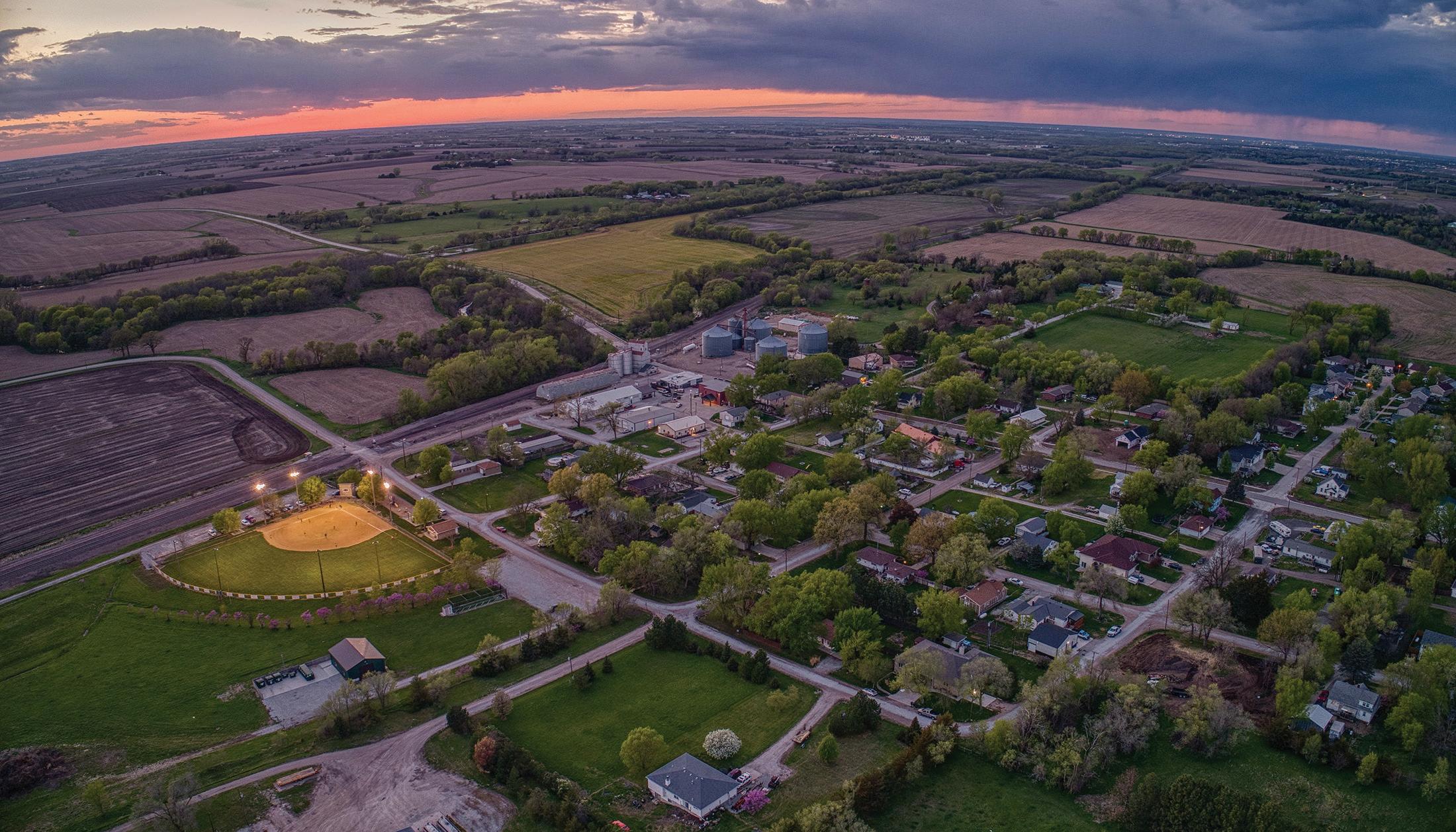
BY JENNA EBBERS, LINCOLN JOURNAL STAR
In William Paxton’s eyes, his hometown was the perfect place to grow up — and someday it will be the perfect place to call home again. The small town of Stuart in northern Nebraska, where he was born and raised, has everything he could want in a community. It’s tight-knit, comfortable and flourishing.
He can see Stuart’s potential in the coffee shop that successfully opened a year ago near the highway that runs by town, proving small businesses can thrive there. The power of the community’s selfless demeanor can be seen at the local movie theater, too, which is completely run by volunteers in the town with just over 500 residents.
It’s a place where everyone knows everyone, and if anything were to happen, the community members have each other’s backs. He feels safe and protected there.
“My hometown has shaped me into the man I am today. It has taught me the difference between right and wrong. It's taught me what a good person is,” he said. “When I look around, I see community members that will help any new business and are the first to be there if someone's injured.”
“I just look at how many people are serving each other, and how it’s all without anything in return. They continue to serve each other, and that’s why I love my rural community,” he added.
Because of all of this, Stuart is where Paxton can envision himself living for the rest of his life.
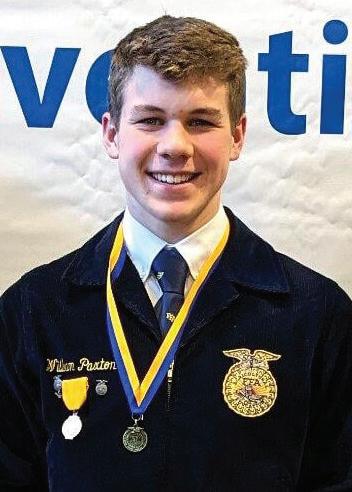
William Paxton
Young Nebraskans are just extraordinary, and we should be doing everything in our power to either keep them here or give them reasons to move back. “ ”
Carrie Malek-Madani
Director of Marketing & Communications, NCF
And a recent statewide survey shows that Paxton, now a freshman at South Dakota State University, might not be the only student in rural Nebraska who feels this way about small towns.
Paxton was one of thousands of students across the state to complete the annual Nebraska Youth Survey, asking middle and high school students from rural communities their thoughts and perceptions of their small hometowns.
The survey, produced by the Nebraska Community Foundation and the Center for Public Affairs Research at the University of Nebraska at Omaha, was given to more than 4,000 students at 43 different rural schools over the past five years to identify how to attract and retain young people in the state.
Students were asked a variety of questions such as what their ideal size of community is, how likely they are to live in rural Nebraska later in life and what characteristics they look for in a community.
Consistently, more than half of the students surveyed each year said they are somewhat or extremely likely to live in the area they currently live in when they are adults. Additionally, a majority of students said their ideal community size is small like their hometowns. Students also reported not feeling a negative stigma around returning to or staying in their small towns after high school.
The survey also showed that many students listed safety, good schools and close proximity to family as priorities when choosing a place to call home — all of which they say they can find in their hometowns, said Carrie Malek-Madani, the director of marketing and communications for the Nebraska Community Foundation.
“This is really good news,” she said. “I think this survey really points to a bright future for greater Nebraska.”
However, while most students over the course of the survey said they feel connected to their communities, an overwhelming number of participants reported they don’t feel like they play an actual role in the community, which presents a big problem for rural towns, said Josie Schafer, the director of the Center for Public Affairs Research.
Despite many students having jobs in high school, Schafer said the opportunities for internships or job shadowing,
which could be more meaningful to students, may be lacking in some small towns.
By creating more opportunities to expose students to the variety of careers available in rural areas, Schafer said it could lead to students truly feeling like important members of the community. Simply showing students that they’re wanted in rural Nebraska could make a huge difference in the retention of young residents, she added.
“That’s that distinction that really makes them go, ‘Oh, I didn’t just have a good experience there. I had a great experience there, and I’m needed there. I made a difference in that community. I want to keep making a difference in that community,’” she said.
For Paxton, who took the survey all four years of high school, his answers changed over time, he said. When he first answered the questions as a freshman, he didn’t fully grasp the importance of what he was being asked. But, as an upperclassman, Paxton said the survey helped open his eyes to how much his hometown meant to him, and that he could envision a future in Stuart.
This conversation even led him to write a speech for the national FFA competition this month titled “Rural America: The American Dream,” which is about the importance of rural communities and what life in a small town really looks like.
Once he graduates from SDSU, where he’s majoring in agricultural business and entrepreneurial studies, Paxton hopes to return to Stuart someday to open his own business and give back to the community he was raised in.
“Through high school, I just realized the importance of my own rural community, and it’s something I’ve become passionate about,” he said.
When the first round of surveys was sent out in 2020, Malek-Madani expected the results to show more students with plans to leave their hometowns forever, or for students to care less about safety and schools, and more about entertainment. Without listening to students’ voices, like Paxton’s, they may never have known how young people in the state actually felt about rural Nebraska.
Continued on page 12 / See Community
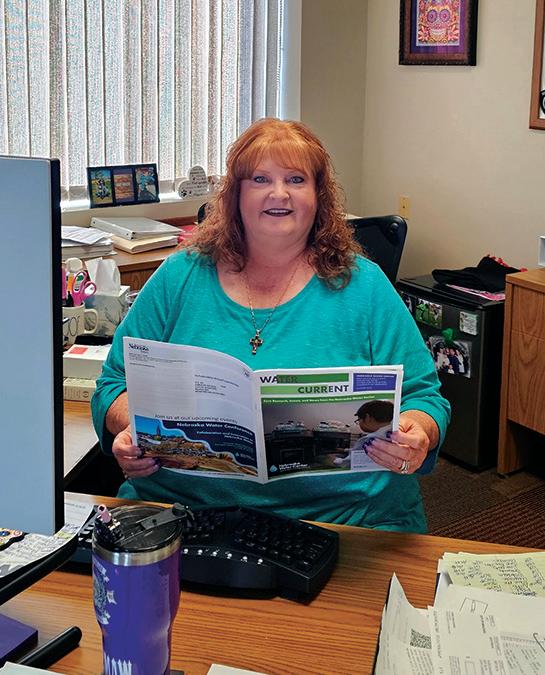
Editor’s note: The City of Minatare has a new face at the City Office. Thank you to Celeste Sanchez for sharing this with the Review.
Karen Lojka was raised in and graduated from Gering. She and her husband Kevin have been married 36 years and have one daughter, Kayla. They also have two grandsons, ages 9 and 7.
Most of Karen’s married life has been spent in and around Minatare. She began working with customers at the age of 14 with a job at the Little Red Dairy Kone. Most of her work experience in adulthood has been with law firms in Scottsbluff, but also has experience working with municipalities and utilities as well.
In her off time, she enjoys riding her motorcycle with family and friends
Continued from page 11
Now, it’s important to continue listening, she said.
“Young Nebraskans are just extraordinary, and we should be doing everything in our power to either keep them here or give them reasons to move back,” she said.
Schafer and Malek-Madani plan to continue the conversation around what students in small towns want for their futures, and find ways to use the data to help communities build
and is a member of the Guardian Belles Law Enforcement Riding Club, serves as the Treasurer of her chapter, and as the National Chaplain for all the chapters throughout the country.
In the winter Karenn enjoys crime dramas and diamond painting. She said that she is excited about this job because it utilizes more of her skills, she enjoys challenges and this is a nice balance between customer service and bookkeeping.
In her submission recognizing Karen, Celeste added, “I have noticed she is very meticulous and organized, pays attention to detail and her time management is extraordinary.”
their population of young residents. They don’t have any plans for the survey to end anytime soon.
“I don’t anticipate a day when we will cease to care about what young Nebraskans think about their communities,”
Malek-Madani said. “It’s going to continue to be an integral part of the work that we’re doing.”
Reprinted with permission from the Lincoln Journal Star.
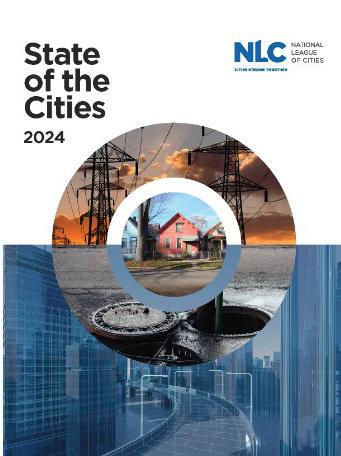
The2024 National State of the Cities report summarizes the challenges cities, towns, and villages face and the innovative solutions that mayors nationwide employ these issues.
In its 11th year, the National League of Cities' report offers an in-depth exploration of the complex challenges confronting municipal governments and the strategic objectives city leaders set to elevate the quality of life for their residents. It also explores the predominant themes that surfaced in the 2024 mayors' annual addresses. This year's report includes new sentiment research, revealing a clear alignment between resident concerns and mayoral priorities. View the report at nlc.org/resource/state-of-the-cities-2024.

The League Insurance Government Health Team (LIGHT) helps hundreds of its members throughout Nebraska obtain affordable health insurance coverage.
With seven plan options and three networks to choose from, you’re sure to find one that meets your group’s coverage and benefit needs.
Offering your employees much-needed protection against the high cost of medical care:
• Three PPO options
• Four HSA-eligible high deductible options
• Prescription drug coverage
Single: Covers the employee only
Employee and spouse: Covers the employee and their spouse
Employee and children: Covers the employee and their eligible dependent children, but does not provide coverage for the spouse
Family: Covers the employee and eligible dependents including a spouse
RECEIVE DEDUCTIBLE AND OUT-OF-POCKET CREDIT FROM YOUR CURRENT VALID GROUP PLAN WHEN YOU SWITCH!
With several networks available, you have easy access to quality providers:
• NEtwork BLUE (Statewide)
• Premier Select BlueChoice (Regional)
• Blueprint Health (Regional)
• Out-of-state network availability
Contact your current local Agent/Broker Or contact
Dennis Maggart
Executive Vice President P: 913-378-9841 or 816-718-0335
Dennis@McInnesGroup.com
Jane Limbach
Account Man ager P: 913-378-9840
Jane@McInnesGroup.com

Thank you to the City of Sutton for sharing how they are thinking outside the box and addressing housing needs for their municipality
STORY SUBMITTED BY: CITY OF SUTTON STAFF
In the summer of 2017, the process to update Sutton’s comprehensive plan started taking shape with both community and council leadership sharing insights on priority issues within the community. Housing needs were identified as a priority and potential areas around the city which realistically could be considered for development were identified. Several one-on-one discussions with landowners owning adjoining ground around the city were initiated, planting the seeds of consideration to those landowners for the future development and growth of the town with a new subdivision. In 2021, regular conversations began with Thomas Schwab, a Sutton alumnus living in California, about an eighty (80) acre parcel directly east of the Fox Hollow Golf Course that he owned. After numerous discussions, the City of Sutton leadership and Mr. Schwab agreed on a 1031 swap of Mr. Schwab’s 80 acres for city owned ground that would be of equivalent agricultural value. In the spring of 2022, ground was purchased by
the City which matched the agricultural land value of the Schwab property and the 1031 swap was initiated. Immediately following the land swap, JEO Consulting began the engineering for the layout and infrastructure for the ‘Schwab Subdivision’. An initial design plan for the entire 80 acres was completed allowing for a vision for the future of the entire development but planning for the work to be done in two phases. Phase #1 of the project would contain 51 residential lots, a retention pond, with Phase #2 containing 60 residential lots. A future park and walking trail were also included in the design. The project began by developing the north forty (40) acres abutting Hickory Street coupled with a full renovation of Hickory Street along the subdivision and connecting to French Street. The design of the project was slightly adjusted throughout that year with community and council input and the final plans were approved summer 2023 allowing Phase #1 of the development to move forward. The contracted work
Continued on page 21 / See Sutton
The Nebraska Department of Environment and Energy (NDEE) has announced the award of more than $958,000 in Energy Efficiency and Conservation Block Grant (EECBG) funding to 12 Nebraska communities. Nebraska received EECBG funds from the U.S Department of Energy (DOE) through the Bipartisan Infrastructure Law. This grant supports local communities in implementing high-impact, self-sustaining clean energy projects. “These EECBG funds will go toward projects that will provide community-wide benefits and help our communities become more energy efficient,” NDEE Interim Director Thad Fineran said. Eligible projects included upgrades to energy efficient lighting; installation of renewable energy systems on government buildings; development of alternative transportation infrastructure such as pedestrian walkways and bicycle paths; and public education to promote energy efficiency and conservation.
• Beatrice – $58,041 to fund energy efficient lighting in the city’s auditorium and police station
• Bloomfield – $71,682 to fund energy efficient lighting and windows in the city library
• Curtis – $87,871 to fund energy efficient streetlights on Highways 18 and 23
• Hickman – $100,000 to fund energy efficient streetlights and street signs
• Mitchell – $24,324 to fund energy efficient lighting at city hall, the police department, the senior center, and the library
• Nebraska City Utilities – $100,000 to fund energy efficient streetlights along the main streets or entrances to Bennet, Douglas, Palmyra, Unadilla, Otoe, Lorton, Julian and Brock.
• North Platte – $100,000 to fund energy efficient lighting at city hall, fire stations #2 and #3, the rec center, the senior center, and the ball field
• Peru – $81,731 to fund energy efficient streetlights along the downtown/ business district
• Shickley – $83,148 to fund energy efficient streetlights
• South Sioux City – $100,000 to fund energy efficient lighting at the ball field
• Wahoo – $100,000 to fund energy efficient streetlights
• Walthill – $51,696 to fund solar streetlights
Source – Nebraska Department of Environment and Energy




BY STEPHANIE MARTINEZ-RUCKMAN, LEGISLATIVE DIRECTOR OF HUMAN DEVELOPMENT, NLC and MCKAIA DYKEMA, LEGISLATIVE RESEARCH MANAGER, NLC

The 2024-25 U.S. Supreme Court Term officially kicked off on October 7. Several significant cases that could impact local governments and their interests are before the court this term. The National League of Cities (NLC), through partnership with the Local Government Legal Center (LGLC), has joined several amicus briefs supporting and advocating local government positions on key legal issues of relevance.
Cases of importance this term include questions of employment law issues related to Title VII and the Fair Labor Standards Act, environmental law and the permitting requirements under the Clean Water Act, the scope of authority for a federal regulation relating to “ghost guns,” when attorney’s fees can be assigned and the Americans with Disabilities Act. As the Supreme Court accepts additional cases to their current term docket, NLC will keep local leaders informed on important cases that impact local governments.
AMES V. OHIO DEPARTMENT OF YOUTH SERVICES
This case is related to an important employment law question under Title VII. Title VII of the Civil Rights Act of 1964 prohibits discrimination in employment based on race, color, religion, sex, or national origin. The specific issue is whether a plaintiff that belongs to the majority group of a class must show “background circumstances” supporting the suspicion that the defendant is an “unusual employer who discriminates against the majority.” This would be an additional element that the plaintiff must prove in addition to pleading the other elements of a Title VII discrimination claim.
This “background circumstances” test is one that the lower court found was required, given that the plaintiff was a member of the majority group in this case. The court explained that a plaintiff can meet this additional showing with evidence that a member(s) of the relevant minority group of the class made the employment decision at issue or by showing a pattern
of discrimination by the employer against members of the given majority group.
As local governments collectively continue to be one of the largest employers in the country, this is an important case that could impact the expansion of local government liability. Lawsuits under Title VII are expensive to defend and resource intensive for local governments. A ruling that applies the background circumstances test would make it harder for employees in majority groups passed over for promotions or subject to adverse employment decisions to bring Title VII lawsuits.
This is another employment law case related to the power burden of proof level that employers must satisfy to demonstrate the applicability of a Federal Labor Standards Act (FLSA) exemption to overtime pay. Generally, under FLSA, employers must pay employees overtime pay at a rate and a half for all work done above 40 hours a week. However, there are a number of exemptions from the FLSA’s minimum wage and overtime requirements. The exemption relevant to this case is the “outside sales” exemption, which exempts employers from paying overtime for work done outside the office.
At issue in this case is the level of the burden of proof that must be demonstrated to show that the exemption applies. The parties disagree on whether the burden should be a “preponderance of the evidence” (the evidence shows more likely than not) or “clear and convincing evidence” (a significantly higher threshold).
This case directly impacts the burden of proof that local governments will need to show as an employer to demonstrate an exemption to overtime under FLSA. Claims under the FLSA are extremely common, and the burden of proof applies to each of the numerous exemptions. If the court finds that the higher standard of burden of proof applies, it will create significant financial implications for cities. Given the severe penalties for violating the rules under FLSA, there are significant potential liability issues at stake in this case for local governments.
The issue in this case is whether the U.S. Environmental Protection Agency (EPA) can impose generic prohibitions in their National Pollutant Discharge Elimination System (NPDES) permits without identifying specific limits to which pollutant discharges must conform.
Under the Clean Water Act (CWA), the EPA has the authority to issue National Pollutant Discharge Elimination System (NPDES) permits that contain pollutant levels to provide manageable and precise benchmarks for enforcement. Contrary to the requirements of the CWA and EPA guidance, the permits EPA regularly issue impose generic prohibitions against pollutant discharging in a manner that contributes to exceeding applicable water quality standards. The generic prohibitions that are used in the NPDES permits issued to localities around the country create uncertainty and increase the risk that local governments will be subjected to significant penalties. The generic water quality terms in the permits expose permitholders nationwide to enforcement actions while failing to tell them how much they need to limit or treat their discharges to comply with the CWA. A decision in this case would provide clarity to local governments on CWA requirements.
The issue in this case is whether a weapon parts kit that has been designed to or may readily be converted to expel a projectile by the action of an explosive is considered a “firearm” regulated under the Gun Control Act of 1968 (GCA). The GCA is the federal law that imposes licensing, background checks, recordkeeping, and serialization requirements on persons engaged in the business of importing, manufacturing, or dealing in firearms. In 2022, the Bureau of Alcohol, Tobacco, Firearms and Explosives (ATF) issued a regulation that clarified the definition of “firearm” under the GCA includes products and kits that can “readily be converted” into an operational firearm or a functional frame or receiver. These types of products are commonly referred to as “ghost guns.”
Ghost guns create significant public safety concerns for local law enforcement as they allow minors and felons who are otherwise prohibited from owning guns under the GCA to obtain them without any background checks or serialization
Continued on page 18 / See NLC
Continued from page 17
requirements. This lack of serial numbers has created significant roadblocks for law enforcement in investigating violent crimes, as they cannot typically be traced. The Court will determine whether these “ghost gun” products are subjected to the requirements of the GCA or if these types of products do not meet the definition of a “firearm.”
The issue in this case involves the important question of deciding when attorney’s fees apply for plaintiffs in civil rights cases. Section 1988 of the U.S. Code provides that a prevailing party may collect attorney’s fees in certain civil suits (including Section 1983 actions). The Court will determine in this case what “prevailing” really means. The specific question is whether a plaintiff who obtains a preliminary injunction can obtain attorney’s fees under Section 1988 if there is never a permanent injunction or full ruling on the claim’s merits since the defendant voluntarily changed their conduct. As local governments are party to civil suits (including under Section 1983 actions), a limitation in the award of attorney’s fees would result in a significant financial victory for local governments involved in these types of cases. Attorney’s fees can be as high or higher than the underlying liability or damages of a civil suit, and they regularly cost governments hundreds of thousands or millions of dollars. If the Court rules that attorney’s fees are appropriately awarded only when there is a conclusive ruling, this would significantly reduce future potential civil litigation costs for local governments.
This case presents a question of whether a former employee can sue itsemployer under the Americans with Disabilities Act (ADA) for discrimination in postemployment distribution of fringe benefits if he or she no longer holds the job. Title I of the ADA prevents discrimination against individuals with disabilities regarding compensation and other terms of employment. Lower courts found that a former employee doesn’t qualify as an “individual with a disability” and therefore cannot bring suit for discrimination in post-employment distribution of fringe benefits.
Local governments are sometimes faced with difficult decisions when balancing the public fisc with other local government operations or initiatives. As local leaders continue to look for cost-saving mechanisms to balance their budgets, some may look to postemployment benefit liabilities as a place to potentially cut costs and fulfill their duties of fiscal responsibility. This case is important to ensure local governments have the flexibility and authority they need to make these difficult decisions without the threat of litigation.
Engineering a world where everyone thrives.





Cultivating Healthy Environments – Region 7 is a part of the national Environmental Justice Thriving Communities Grantmaking program (EJ TCGM) and is partnering with the U.S. Environmental Protection Agency (EPA) to support communities in EPA Region 7 to cultivate and sustain healthy environments.
The organziation makes it easier for community-based organizations to apply for federal grants that address environmental issues. No cost matching is necessary.
The grantmaking program is designed to empower communities to pursue grants that address local priorities.
The TCGM Region 7 grantmaking program serves 4 states and 9 Tribal Nations. There are also TCGM programs serving organizations within EPA Region 4, Region 5, Region 6, and TCGM National-Central which serves groups across Regions 4-7.
Learn more on the TCGM Region7 websitehttps://region7.thrivingenvironments.org/
Editor’s note: Thank you to Mandy La Brier from the Heartland Environmental Justice Center for sharing this information. You can reach Mandy here: mandy.labrier@wichita.edu

Congratulations to Dave Gobar for 30 years, Stephanie James for 25 years, Brook Andersen for 20 years, Adam Woldt for 15 years, and Gary Clark for 5 years of service to the City of Wisner. Pictured with them is Randy Woldt, City Administrator/Utility Superintendent. Not pictured is Gary Clark. Thank you for your dedicated service to your community! Photo by City of Wisner/ Posted to City Facebook page.

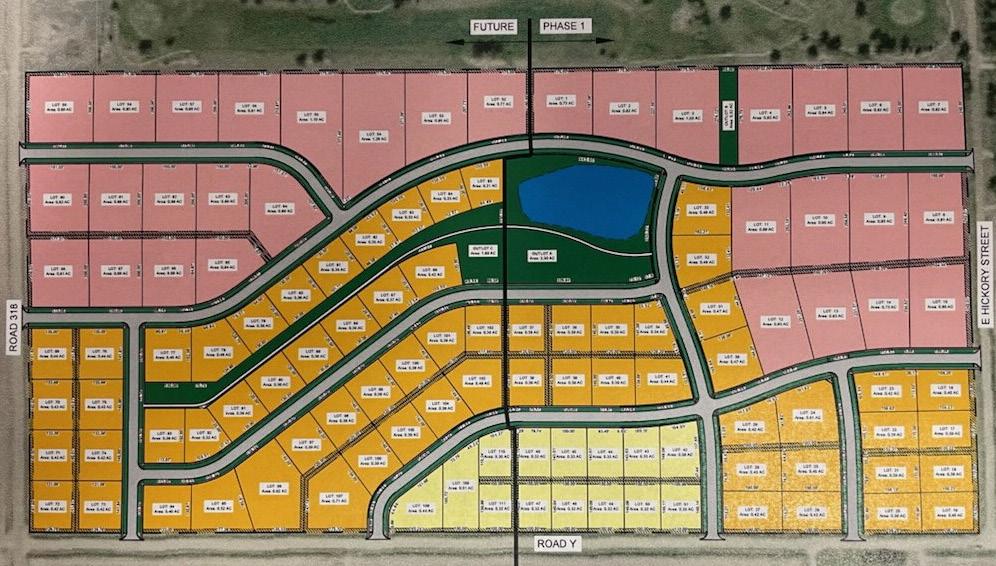
Continued from page 14 for the Schwab Subdivision infrastructure was advertised for bid in the late summer of 2023, with Sutton-based Van Kirk Bros Contracting, a construction firm with decades of experience with heavy construction and underground utilities, being awarded the contract. Almost immediately, excavation and leveling work began on the project which, due to a mild winter, continued throughout the end of 2023. Street contouring and utility work started in spring 2024 and substantial completion of the project was accomplished in August 2024, including the Hickory Street improvement project.
During the initial planning phase, the ground was annexed into the city, a blight study completed, and a redevelopment plan was created to allow for financial support through Tax Incremental Financing (TIF) revenue for the infrastructure cost. The costs of such a large project would not be financially viable but for the long-term financial TIF support to help make the amortized bond payments.
The Sutton Community Redevelopment Authority (CRA) worked in collaboration with the City Council on the covenants and redevelopment plan for the project. Transition of the 51 Phase #1 lots from the City to the CRA occurred early in 2024, and the CRA
started marketing the lots in May 2024 utilizing two local real estate companies. At this time, eight lots have been sold and housing construction has started on three of the lots. Marketing of the new subdivision lots in Phase #1 continues, with the unofficial goal to sell six lots each year. By reaching this goal of 75% (39 lots) of the total being sold and hopefully developed by 2030, Phase #2 of the Schwab Subdivision could conceptually move forward having already been designed.
“Sutton has a long history of strong leadership among its citizens and businesses to look beyond the horizon and take progressive steps to ensure the community continues to maintain its established businesses and attract families back to the community,” stated Mayor Tim Anderson. The community is one of only around 70 across Nebraska that has a local option sales tax for economic development (LB840 program). Sutton has a separate local option specifically for parks/recreation projects, such as maintaining the DLD baseball & softball field complex. Community development is important to Sutton citizens and the city leadership. The new Schwab Subdivision continues to prove Sutton’s commitment to continued growth of the community and its dedication toward attracting families back to live, work and play in our rural Nebraska.

The City of Wayne has been strategically investing in its community for years and it is making a big difference in terms of bringing new economic opportunities to town and encouraging people to put down roots and stay.
The community, with a population of 6,133 and nestled in northeast Nebraska, recently earned recognition from the Department of Economic Development (DED) for earning its recertification as an Economic Development Certified Community (EDCC). Wayne is one of 41 communities in this statewide program and this is its fourth certification.
For the community of Wayne, the focus has really been on putting funding toward infrastructure investments to promote economic growth. City officials have leveraged both state and federal programs to create opportunities for business development, new infrastructure, and recreational assets.
Nebraska’s Civic and Community Center Financing was used for the Prairie Park recreational project. The project, which is ongoing, will expand the parks and recreational offerings for the community, while also transforming a previously decommissioned sewage lagoon. This multi-phase project will cost between $12-15 million and include a four-acre lake, an outdoor amphitheater, and 17 full-service camping pads. The development will also include new baseball, softball, and soccer fields, playground equipment, walking trail additions and extensions, and updated parking areas. Prairie Park will also serve as the headquarters for the City of Wayne’s Parks & Recreation Department. This development also helped seed interest in additional housing— right next door to Prairie Park will be a new apartment complex funded through private investors. Prairie Park Apartments will add 144-units to the community.
Tax Increment Financing dollars were utilized in collaboration with the City of Wayne to develop Prairie Park Lake, which is near the recreational area and apartments. TIF projects encourage private investments in deteriorating areas by allowing city governments to help repay for increased public investments in property taxes spurred by new development.
While all the projects culminating at once can cause many challenges from financing to logistical coordination, I wouldn’t want it any other way. Many communities are not seeing this same growth and private investment.
In 2022, the City of Wayne received federal Community Development Block Grant funding to expand the Wayne Pedestrian Trail System. The funding will help connect the system from residential areas to the major retail corridor, which will create additional trail accessibility. The trail improvements are inclusive to mobility-constrained users in compliance with the Americans with Disabilities Act. CDBG dollars are funded by the U.S. Department of Housing and Urban Development and administered by NDED.
Wayne Mayor Cale Giese credits collaborative community attitudes in the tremendous impact of growth within the community.
“Over the past five years, the City of Wayne has experienced tremendous success and has seen first-hand the benefits of strong partnerships within the community,” Mayor Geise explained. “From local investments in education, finance, health care, housing, infrastructure, recreation, and tourism to major business expansions in wind energy, manufacturing, and retail, nearly every sector of Wayne America has been impacted. With partners like Wayne County, Wayne State College, Wayne Community Schools, Providence Medical Center, Wayne Community Housing, Wayne America, Inc., and our entire business community, we look forward to another five years of collaboration and growth.”
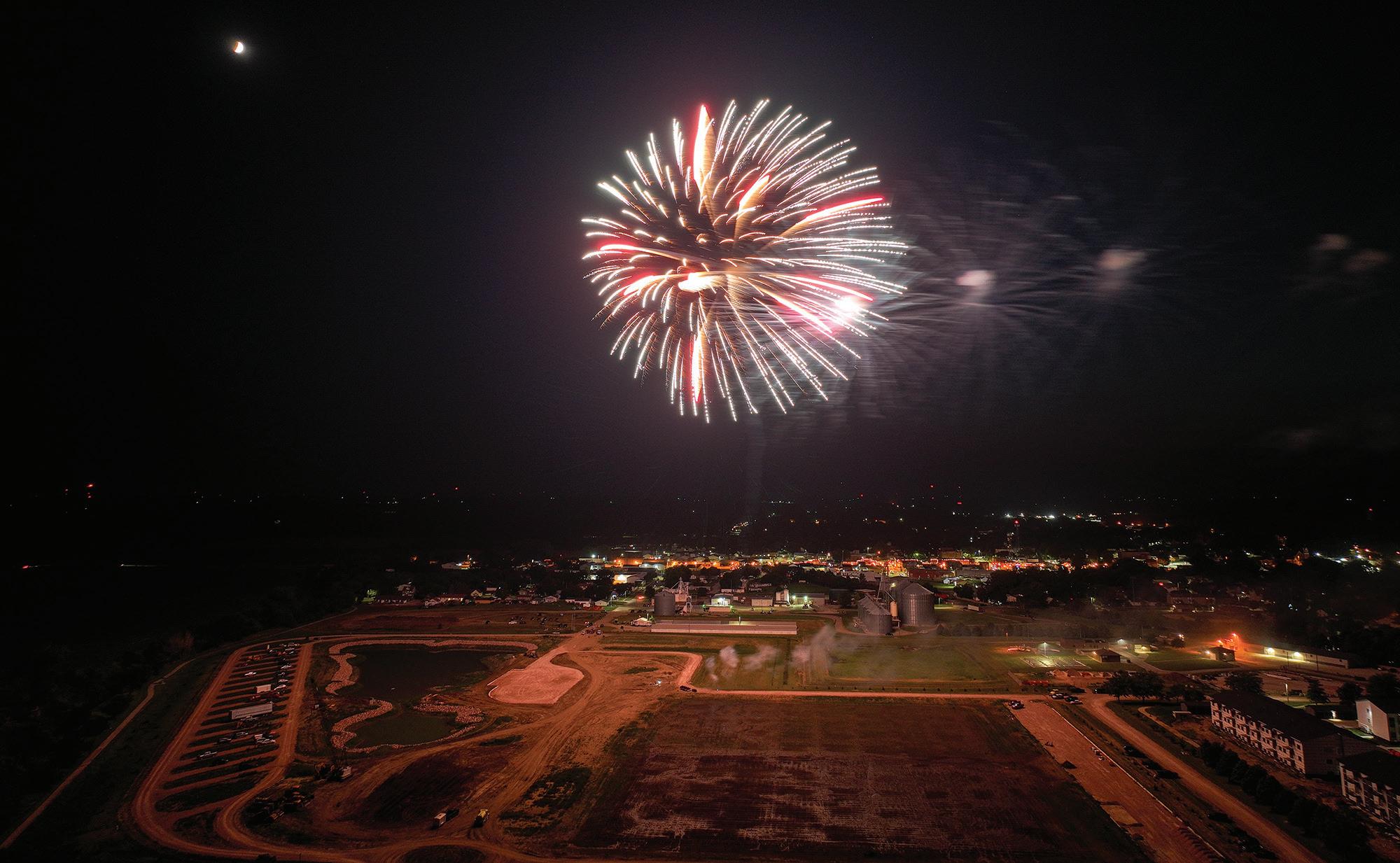
The City of Wayne continues to build momentum for additional multi-year development efforts led by city leaders. In 2022, residents voted to continue the Local Option Municipal Economic Development program (LB840) in the City of Wayne, which authorizes cities and villages to collect local sales tax dollars for economic development projects.
The City of Wayne has leveraged its local option sales tax revenue into the Wayne Aquatic Center, ADA upgrades at recreational facilities, library and senior center updates, police and fire vehicle replacements, and street improvement projects. Additionally, the sales tax revenue is being used to reinforce a strong Business Revolving Loan fund, which has invested over $5 million in local businesses, and the Wayne Public Art Committee, which supports public murals and other art installations throughout the community.
But this isn’t even all of it. According to Wayne City Administrator, Wes Blecke, the city is also remodeling and adding on to an old call center it purchased for a new City Hall and police department, Blecke said.
How can a community the size of Wayne support all of this and future growth? That is already on the radar for City leaders.
“The other large project just starting after purchasing 60+ acres is a new electrical substation and new electric generation plant,” Blecke said. The remaining acres not used for the electric projects will be used for other future development projects.”
“While all the projects culminating at once can cause many challenges from financing to logistical coordination, I wouldn’t want it any other way,” Blecke said. “Many communities are not seeing this same growth and private investment.”



BY TARA STINGLEY, MADELINE HASLEY AND SYDNEY HUSS, CLINE WILLIAMS WRIGHT JOHNSON & OLDFATHER, L.L.P.
OnNovember 15, 2024, the U.S. District Court for the Eastern District of Texas set aside and vacated the U.S. Department of Labor’s (DOL) final rule that increased the Fair Labor Standards Act’s (FLSA) salary level-threshold for the “white-collar” exemptions to overtime requirements. The court’s ruling applies nationwide to all employers who are subject to the FLSA.
By way of background, in April 2024, the DOL issued a final rule raising the whitecollar exemption salary threshold. The final rule increased the salary threshold for executive, administrative, and professional exemptions in two phases. Specifically, on July 1, 2024, the salary threshold increased from $684 per week ($35,568 per year) to $844 per week ($43,888 per year). i Additionally, on January 1, 2025, the salary threshold was to increase to $1,128 per week ($58,656 per year).ii
The rule also increased the total annual compensation requirement for highly compensated employees, with increases on July 1, 2024, and again on January 1, 2025.iii
The DOL also set forth a schedule for automatic increases to the salary threshold every three years.iv
Shortly after the 2024 final rule became effective, the State of Texas and a coalition of business organizations challenged the final rule arguing the DOL exceeded its authority under the FLSA.
In an order issued on November 15, 2024, the U.S. District Court for the Eastern District of Texas analyzed the impact of the 2024 final rule. Issuing a thorough 62-page order, the court held the changes to the salary threshold for the executive, administrative, and professional exemptions are “designed on their face to effectively displace the FLSA’s duties test with a predominate—if not exclusive—salary-level test.” This, the court held, is beyond the DOL’s statutory authority. Specifically, the court held that the DOL does not have the statutory authority “to make salary rather than an employee’s duties determinative of whether a ‘bona fide executive, administrative, or professional capacity’ employee should be exempt from overtime pay.”
The court further held “the analysis regarding the legality of the changes to the standard [executive, administrative and professional exemptions] salary level” applies equally to the DOL’s changes to the highly compensated employee exemption. Furthermore, the court held the DOL does not have the statutory authority to use indexing or automatic increases for future increases.
Finally, the court vacated the DOL’s 2024 final rule on a nationwide basis after finding that the final rule has nationwide impact on “millions of employees in every facet of the economy, as well as state and local governments, and will impose billions in costs to employers.”
In light of the court’s ruling, the increase in the salary threshold scheduled to become effective on January 1, 2025, and the automatic increase every three years thereafter, will not go into effect. In addition, the increase that went into effect on July 1, 2024, was nullified, meaning employers are no longer obligated to comply with it.
The DOL can appeal the decision to the Fifth Circuit. However, if appealed, it is highly likely the appeal will be withdrawn by the incoming DOL under the new Trump administration.
At this time, the court’s ruling means that the DOL’s 2024 final rule is not effective. Accordingly, employers can operate and compensate employees in accordance with regulations that existed pre-April 2024. This means to be exempt from overtime under the FLSA’s executive, administrative, and professional exemptions, an employee must be paid on a salary basis of at least $684 per week ($35,568 per year) and meet the duties tests. In addition, the effective annual compensation for highly compensated employees is $107,432.
Prior to the court’s ruling, the DOL’s 2024 final rule had caused many public employers to revisit their classification for employees for purposes of the FLSA’s minimum wage and overtime requirements, particularly those employed as high-ranking first responders, such as police chiefs, fire chiefs, and emergency medical service directors. The effect of the DOL’s 2024 final rule as applied to these high-ranking first responders was discussed in the October 2024 publication of the Nebraska Municipal Review. v Public employers should be aware that while the DOL’s final rule is no longer effective, the court’s ruling does not impact the other FLSA classification requirements outlined in the October 2024 article.
Employers should also keep in mind that several states (including California, Colorado, New York, Washington, and Alaska) and some local jurisdictions have adopted their own salary thresholds for certain exemptions that exceed the FLSA’s threshold. Employers should confirm the law for the jurisdiction in which they have employees to ensure the applicable salary threshold is satisfied. This ruling may come as a relief to some employers. However, it is also likely to cause frustration among other employers who have gone to great lengths over the last several months to evaluate their compensation and employee classification structures to comply with the new regulations. Employers are free to roll back those compensation and classification changes, but in doing so, they should consider the financial impact on such changes and the potential adverse impacts on employee morale. Employers should consult with legal counsel on implementing and communicating those changes.
Editor’s Note: This article is not intended to provide legal advice to its readers. Rather, this article is intended to alert readers to new and developing issues. Readers are urged to consult their own legal counsel or the authors of this article if they wish to obtain a specific legal opinion regarding their particular circumstances. The authors of this article, Tara A. Stingley, Madeline S. Hasley, and Sydney M. Huss can be contacted at Cline Williams Wright Johnson & Oldfather, L.L.P., tstingley@ clinewilliams.com, mhasley@clinewilliams.com, shuss@clinewilliams.com or www.clinewilliams.com.
i Defining and Delimiting the Exemptions for Executive, Administrative, Professional, Outside Sales, and Computer Employees, 89 F.R. 32842 (proposed Sept. 2023) (to be codified at 29 C.F.R. pt. 541).
ii Id.
iii Id.
iv Id.
Davidson & Co. is committed to strengthening the infrastructure and enriching the lives of people in our communities throughout Nebraska and across the nation.
Our bankers specialize in:
• Bond Anticipation Notes
• Paving Bonds
• Water and Sewer Bonds
• General Obligation Bonds
• Utility System Revenue Bonds
• Lease-Purchase Financing
Call:
(800) 528-5145 I Paul Grieger (866) 809-5596 I Cody Wickham (866) 809-5443 I Andy Forney (866) 466-9368 I Jerry Spethman

v Tara A. Stingley & Sydney M. Huss, Application of FLSA Overtime Requirements to High-Ranking First Responders, Nebraska MuNicipal review, October 2024, at 22, available at https:// www.lonm.org/news/publication-links/ nebraska-municipal-review.html

The Mid-America Economic Development Council honored Norfolk with two prestigious awards at its annual Economic Development Awards ceremony, held Dec. 4–6 in Columbus, Ohio.
The North Fork Riverfront Development Project earned the Placemaking Award for Large Communities. This initiative transformed a three-mile stretch of riverfront near Norfolk’s downtown district into a vibrant, multipurpose community space. The project features seven engineered rapids, including one designed for river surfing, revitalized Johnson Park, upgraded a main corridor bridge, and renovated two pedestrian bridges—one being a historic train bridge.
“It took the effort of many to bring the Riverfront Development project and Northeast Nebraska Growing Together initiative to life, advancing opportunities for all. We are honored by the awards from the Mid-America Economic Development Council and grateful for their acknowledgment of our work, said Candice Alder, Economic Development Director.
The redevelopment has already catalyzed significant private investment, including a $25 million mixed-use project on adjacent land. Supported by local and state funding, grants, and strong community backing, the riverfront’s revitalization aligns with the Northeast Nebraska Growing Together workforce initiative. It provides an attractive amenity for both residents and visitors, enhancing Norfolk’s appeal as a place to live, work, and play.
The Workforce & Talent Award recognized the innovative Northeast Nebraska Growing Together initiative, a collaborative program designed to attract, develop, and retain talent. This forward-thinking strategy leverages placemaking efforts, such as

the downtown riverfront revitalization, to create community density and foster connections among young professionals.
“I love getting the chance to share the story of our community. This award gave us a great platform to showcase all the efforts we’re putting into making Norfolk a place where young people can build their lives and careers. It’s also a perfect opportunity to highlight to potential new businesses looking to expand to our region that we’re ready for growth and innovation,” said Angie Stenger, Executive Director of Growing Together Northeast Nebraska, powered by Aksarben.
“I’m so proud of what our community has accomplished with the Growing Together Workforce Initiative and the Riverfront Development Project. These awards celebrate our shared commitment to building a thriving workforce and vibrant public spaces, making Norfolk an even better place to live, work, and play. A big congratulations to everyone who helped make these achievements a reality,” said Mayor Shane Clausen.
Source – City of Norfolk
I’m so proud of what our community has accomplished with the Growing Together Workforce Initiative and the Riverfront Development Project. These awards celebrate our shared commitment to building a thriving workforce and vibrant public spaces.
”
The City of Grand Island recently unveiled an updated city website, with new user capabilities and plans to roll out a brand new mobile app.
IN BRIEF
The update offers new capabilities for sharing video content, along with real-time updates on city news and events on the site and via the city’s social media platforms.
“Citizen engagement and transparency are key tenets of our city mission,” Grand Island Mayor Roger Steele said. “This new-look website

has been a long time coming and will provide unprecedented access to city information.”
Source – City of Grand Island
Good news for those closely following the Nebraska Legislature–an official video archive will be available beginning with the 2025 session!
Archived debate and hearings will be posted online within two business days and will be available for eight years. This change comes following the passage of LB 254 in 2023, introduced by Sen. Tom Brewer.
According to an article published by the Nebraska Examiner at the start of session on Jan. 8, there will be an “allencompassing video portal” accessible through the Legislature’s home page.




Workplace harassment and discrimination can negatively impact employees’ well-being, productivity, and morale. Harassment or discrimination based on race, religion, gender, age, disability, pregnancy, or sexual orientation can create a hostile work environment, lower the self-esteem or confidence of the targeted employees causing them stress, anxiety, or depression.
All staff, council, board members, and volunteers should be aware that harassment and discrimination is not tolerated and that there will be consequences for anyone who exhibits this behavior. Periodic training can help reduce cities’ and villages’ exposure to potential liability for such behavior.
Examples of workplace harassment and discrimination include:
• Unfair job treatment based on biases of a protected class
• Engaging in frequent or unwanted advances of any nature
• Commenting derogatorily on a person’s ethnic heritage, religious beliefs, or sexual preferences
• Starting or spreading rumors about a person’s personal life

• Offensive jokes, objects, pictures, or videos
• Name-calling and bullying
• Physical assaults or threats of violence
• Social exclusion
Supervisors have a responsibility to prevent, investigate, and address any incidents of harassment or discrimination that occur. Supervisors who fail to fulfill their obligations may face personal or organizational liabilities, such as lawsuits, fines, penalties, damages, or loss of reputation. It is important that supervisors know relevant laws and policies that relate to workplace harassment and discrimination. Every effort should be made to create a respectful and safe workplace environment.

Some proactive steps to prevent workplace harassment and discrimination include:
•
• Establishing and enforcing a policy that prohibits discrimination and harassment
• Reviewing the policy with all employees and expressing the consequences of engaging in such behavior
• Training all employees in identifying and preventing workplace discrimination and harassment annually and documenting their participation
• Encouraging all employees to report any incidents of harassment and discrimination.
• Thoroughly investigating any evidence or complaints of harassment or discrimination promptly
• Administering and documenting any corrective action taken and protecting victims and witnesses from retaliation
• Demonstrating your commitment to preventing discrimination and harassment through actions, language, and behavior
Contact LARM at larmpool.org for more information on workplace harassment and discrimination model policies, training videos, and workplace harassment complaint forms.
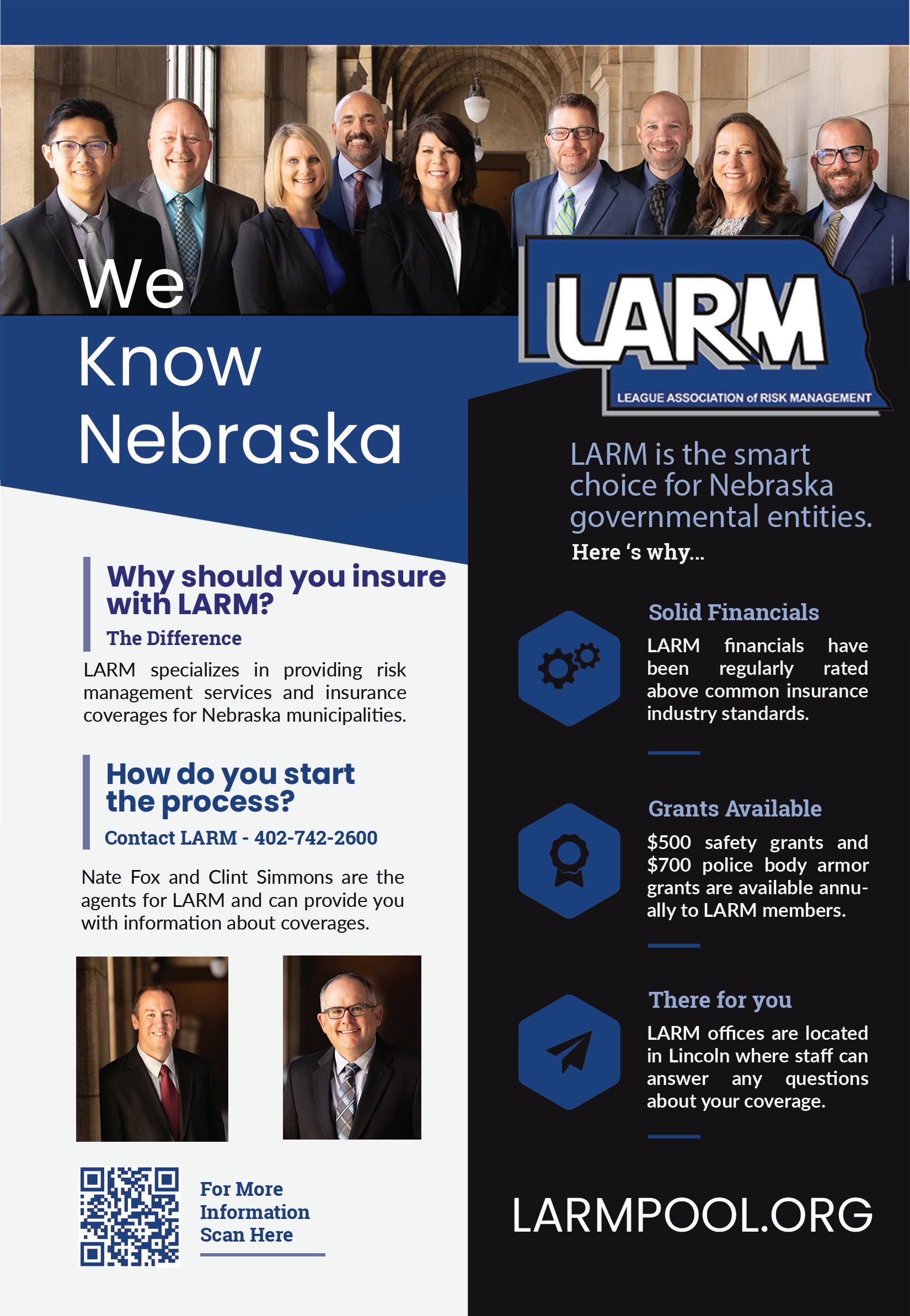
The Nebraska Department of Economic Development (DED) has awarded $10 million to 11 recipients through the Rural Community Recovery Program (RCRP). The Nebraska Legislature authorized this onetime program through LB 1412 in 2023. RCRP is funded with Coronavirus State and Local Fiscal Recovery Funds through the American Rescue Plan Act of 2021.
All RCRP funds are being awarded to applicants with projects located in communities disproportionately impacted by the coronavirus pandemic. The awards will support the rehabilitation or adaptive reuse of vacant or abandoned property.
Rural communities across Nebraska have a profound need for new and improved public amenities and affordable housing. RCRP is proof of this need, as DED received 60 letters of intent to apply and 49 full applications through RCRP. Applicants requested more than $43 million for an array of well-considered projects, resulting in an especially competitive evaluation process.
Source – Nebraska Dept. of Economic Development



P.O. Box 164, Neligh, NE 68756 Phone 402.887.5022 leagle@mcnallylaw.net www.mcodeservices.com




